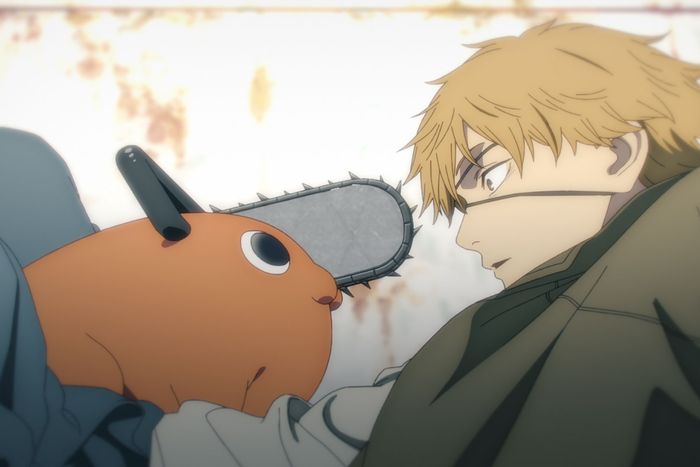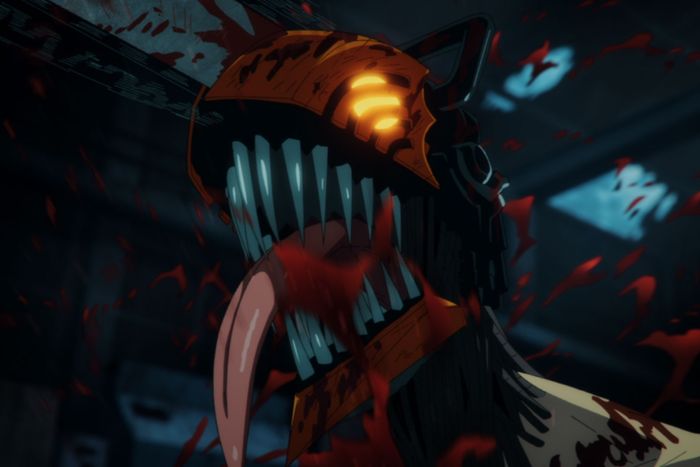
A new anime this season has all the ingredients for killer Halloween viewing. Demons? Check. Crude humor? Check. Lethal power tool? Never leave home without it, especially if it’s literally fused to your body. This isn’t a Sam Raimi project, it’s Chainsaw Man, a new series ready to shred an anime season already stacked with highly anticipated action titles. Despite several long-awaited returns to TV, from Mob Psycho 100 and My Hero Academia to the giant-robot grandaddy franchise Mobile Suit Gundam, there is arguably no bigger premiere this season, or even this year, than Chainsaw Man.
No matter how familiar you are with this title, or even anime in general, odds are you’ve come across Chainsaw Man. Every trailer for the anime adaptation has gotten viewership numbers on par with juggernauts like the latest season of Attack on Titan, all without a single episode having aired. This is a show that had people chanting at conventions. While western TV spun into a frenzy looking for a replacement to fill the Game of Thrones–size void after the show ended in 2019, the action anime world is going through a similar search for its next Attack on Titan, and it may just find it in Chainsaw Man.
If you’re on the fence about the show or have only heard small bits about it and want to know what the big deal is before diving into the season — which now has an English dub set to premiere October 25 — here’s why Chainsaw Man could be your new obsession.
What is Chainsaw Man (and why do chainsaws sprout from his head and hands)?
Based on the manga of the same name by Tatsuki Fujimoto, Chainsaw Man takes place in a world where human fears take physical form and become dangerous “devils,” who lend their powers to humans to wreak havoc across the Earth. They can take many forms: A Tomato Devil, a Gun Devil that has terrorized the world for the past decade, and a primordial Darkness Devil, among others, all exists in this universe — an alternate history where the Soviet Union still exists and World War II never happened.
We meet Denji (voiced by Ryan Colt Levy in the English dub), a destitute 16-year-old drowning in a debt he inherited from his father and forced to sell parts of his body and work as a devil hunter for the yakuza in order to pay it off. His only friend is a cute little devil dog (they also take dog form!) named Pochita (Lindsay Seidel), who fuses with Denji’s heart to resurrect him from after being murdered by gangsters. This turns our young, dumb, horny protagonist into the titular Chainsaw Man, a powerful being who becomes an official devil hunter for the policelike Public Safety Organization with the promise of a decent meal and an actual bed to sleep on.
Chainsaw Man’s violence absolutely lives up to its title. Despite being published in Weekly Shōnen Jump, the long-running magazine that caters to teenage boys — or “shonen” — with tales of heroism, optimism, and friendship (see Naruto, Dragon Ball, and My Hero Academia), Chainsaw Man is closer to Attack on Titan. It’s a “seinen” series, aimed at older audiences, with extreme gore and violence. Again, the protagonist turns into a demon with chainsaws coming out of his head and arms.
It’s not all violence, though, because Chainsaw Man is also funny as hell. A hormonal teen protagonist drives the tone of the story, and the humor is crude and filthy, more like raunchy teen sex comedies than, say, a Marvel-esque stream of one-liners and quips. Once Denji’s job as a devil hunter affords him decent food, he makes it his goal in life to touch any consenting woman’s boobs. From there on, the story becomes what Anime News Network’s James Beckett described in his review of the first volume of the manga as “a mishmash of raunchy teen sex comedies, Hellboy, and The Evil Dead.” Much of the appeal of the early chapters of the manga is the juxtaposition of the extreme violence and gross-out humor belonging to a series published in the same magazine as the home to family-friendly icons like My Hero Academia and One Piece. Thankfully, Chainsaw Man is more than just a parody or a shock-value bloodbath. It’s a comment on the modern working class.
Viscera is cool, but what does the series have to say?
For starters, Denji comes off a lot harsher than the bright-eyed, optimistic kid heroes of popular shonen anime and manga like My Hero Academia or supernatural live-action series like Stranger Things. Denji does not set out on some noble quest, nor does he have a support system that helps him defeat evil. Instead, he is driven by the simple need to not be executed for harboring a demon, and his desire to live a normal life without hunger or poverty. Denji doesn’t care about saving the world, or innocent lives, and he does not mourn the foes he slays but relishes in their deaths.
This is the heart of the Chainsaw Man manga and Tatsuki Fujimoto’s writing. Its world is a horrible, absurd, bleak, illogical place, and we can do nothing but relieve tension by embracing the silliness and making fun of it. When we first meet Denji, we learn how many body parts he’s sold to try and pay off the debt he inherited from his father, and how little it actually meant, as he tells himself he’ll probably die before paying it all off.
The story is more than a little Dickensian, all about the pains of the working class and the effect late-stage capitalism has on the young, of the way we sell our souls to jobs that care nothing about us and exploit us until we drop dead. In Chainsaw Man, the moment that a devil bargained with loses power, your job forces you to sell yet another part of your body or soul to another demon. As soon as Denji kills the zombified yakuza that betrayed and killed him, the Public Safety Division tells Denji that he has two choices: He can either be put down like a dog for his demon powers, or work as a demon killer for them. Either way, he’s under constant threat of being killed.
At every turn, where other manga would give our heroes a victory, a power-up, or a new ally, Chainsaw Man delivers another heartbreak, a massacre, a pointless death, or a betrayal. The world Denji lives in is bleak, and is likely to get worse, but at least you can tell a gross joke, or eat puke, or fart, and make your friends laugh. All the icky humor and the gory violence serve as a respite from the darkness of the story. Unlike other popular action anime, it skips the common tropes of tournaments, mentors, and training segments in favor of showing the personal growth of our characters and their evolving (usually for the worse) worldview.
That focus helped make the manga a hit. Before part one ended earlier this year, Chainsaw Man hit 11 million copies in circulation worldwide — far more than the 8.5 million copies reached by the last major new manga hit, Jujutsu Kaisen, had right before its anime adaptation aired. The Jujutsu Kaisen show ended up becoming incredibly popular, while its prequel film went on to earn almost $200 million worldwide. For Chainsaw Man, the numbers are only expected to go up as episodes start airing and a new audience gets curious for how the story continues past the anime. (The Chainsaw Man manga has been collected into 12 volumes so far, since debuting in 2018, and has not ended yet.)
Okay, that rips. What else should I know about the show?
Two words: Studio MAPPA. Even if you are not familiar with that name, the Japanese animation house has produced some of the most creative and popular titles of the past few years, from Jujutsu Kaisen to Attack on Titan’s final season. MAPPA’s taken a series of unusual production moves for an anime this big and this highly anticipated.
First, the company committed to fully handling the series by themselves — as opposed to the common anime practice of creating a production committee made up of different companies and stakeholders. For the Chainsaw Man anime, every decision has been made between MAPPA and the manga’s publisher, Shueisha, affording the studio a lot more risk-taking than if there were multiple parties involved. This may have helped the show lean more into the gnarly violence of the manga’s fights, as seen in the trailers and the first episode, which faithfully recreates the gore, guts, and violent excitement of the manga’s opening chapter.
Second and more importantly, the studio tapped Ryū Nakayama, who helmed the 19th episode of Jujutsu Kaisen — which was acclaimed for balancing a fan-favorite bromance with some of the most dazzling anime fight sequences of the past few years — to make his series directing debut with the show. It’s rare for an adaptation of such a popular manga to be directed by a newcomer, but as Studio’s CEO, Manabu Otsuka, told Anime News Network, the team wanted a younger generation to lead this story. “We wanted to make sure that the team matches the age of the original author,” Otsuka said. Nakayama and Fujimoto are both millennials born in the early ’90s. The show also tapped the screenwriter who turned Attack on Titan into a global phenomenon, Hiroshi Seko, to write the first season. Seko is older than Nakayama, experience which Otsuka believes Nakayama can lean on as a first-time series director.
For a story that is all about the younger generation clashing with the decaying world left by the old one, this is an intriguing move. Will this experiment work? There is nothing left to do but sit back and enjoy the carnage.
Chainsaw Man premiered in Japanese with subtitles October 11 on Crunchyroll, at 9 a.m. PT/12 p.m. ET. New episodes drop on Tuesdays at that time. The English-dubbed episodes drop a few hours later, at 12:30 p.m. PT/3:30 p.m. ET.






